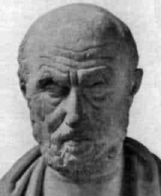

Little is known of Hippocrates' life, but he evidently taught in Athens, and is reported to have been an excellent geometer who lacked common sense. There are stories that he was defrauded of a large sum of money because of his naiveté.
Hippocrates worked on two of geometry's most famous problems: squaring the circle and doubling the cube. In his attempts to square the circle, Hippocrates was able to find the areas of lunes, certain crescent-shaped figures, using his theorem that the ratio of the areas
of two circles is the same as the ratio of the squares of their radii.
Hippocrates also showed that a cube can be doubled if two mean proportionals can be determined between a number and its double. This had a major
influence on attempts to duplicate the cube, all efforts after this being directed towards the mean proportionals problem.
He was the first known geometer to write a geometry book, and although his work is now lost it must have contained much of what Euclid later included in the Elements.
Hippocrates' book also included geometrical solutions to quadratic equations and included early methods of integration.
There is one further remarkable achievement which historians of mathematics believe that Hippocrates achieved, although we do not have a direct proof since
his works have not survived. In Hippocrates' study of lunes he uses the theorem that circles are to one another as the squares on
their diameters. It appears that Hippocrates may have proved this using a variant of the method of exhaustion.